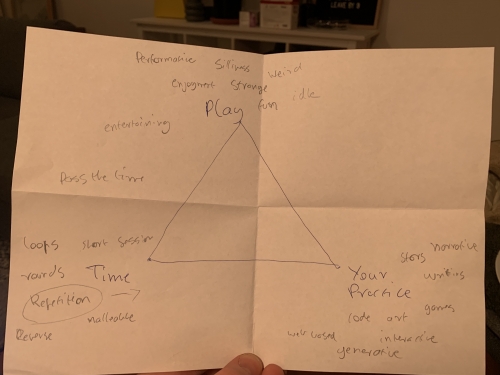
Response : playable here
Gameplay Footage : viewable here
Theme :
I started off this week with the triangle word-cloud exercise, noting down words and ideas relating to the themes of Play, Time and my own creative practice. I very specifically wanted to avoid ideas relating to the passage of time and day / night cycles, as I explored these in a similar themed week for CPS, and wanted to vary up my response.
I found I was drawn to the ideas of loops, rounds and repetition. I was reminded of the idea of 10 second games, a theme that has been used in multiple game jams and game-a-week challenges (Like this one by Firepit Collective, modelled after this class syllabus from 2017), where the extreme time constraint means that the games have simple mechanics, and the enjoyment comes from the race against the clock, and the satisfaction of improving over multiple play-throughs. A good example of a game made under these constraints is ‘Morning Makeup Madness’ by Jenny Jiao Hsia, where the player has 10 seconds to apply makeup to a virtual avatar, and get graded on the results.
I decided I wanted to use the 10 second time limitation, and make a game that was designed to be played in rounds, with the difficulty gradually increasing each round, that also tracked and displayed the players score, to encourage replay-ability.
Method :
For the response I made a 2D game in Unity, where the player controls a bee using their mouse. The goal of the game is to collect every flower on the screen before the timer runs out. When the player collects every flower on the screen they progress a level, which increases the size of the playable area, and the number of flowers that spawn into the scene. If the 10 second timer runs out, the player is shown their high score, and given the option to restart the game from level 1.
Context :
This is the most traditionally game-y of my responses so far, with its focus on mechanics, timers and scores. This means it ties in very well with the idea of ludic or rule based play, where the player operates within a structured system of play (Caillois, 1961). It also fits very neatly into the ‘difficulty’ and ‘‘competition’ categories of the Pleasures of Play framework, where the enjoyment of the experience comes from increasing the difficulty, or the completion of a set task or goal (Costello, 2007).
Reflection :
I had trouble deciding on what I should make for this week’s response, even after I’d settled on the idea of making a 10 second game. Once I came up with the idea of a bee collecting pollen though, the ideas flowed pretty quickly. I also realised that I’m getting a lot more comfortable using Unity, as I was able to develop the prototype, including the majority of the scripting, without having to look up pre-existing tutorials or examples.
References :
Caillois, R., 1961. Man, Play and Games. Chicago: University of Illinois Press.
Costello, B. and Edmonds, E., 2007. A study in play, pleasure and interaction design. In: Designing Pleasurable Products And Interfaces. [online] ACM, pp.76-91. Available at: <https://dl-acm-org.ezproxy.lib.rmit.edu.au/doi/abs/10.1145/1314161.1314168> [Accessed 26 August 2022].
About This Work
By Eamonn Harte
Email Eamonn Harte
Published On: 15/08/2022

